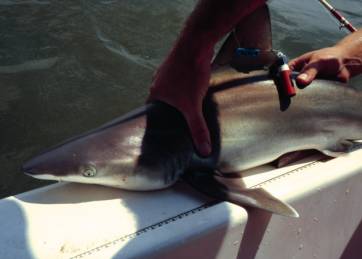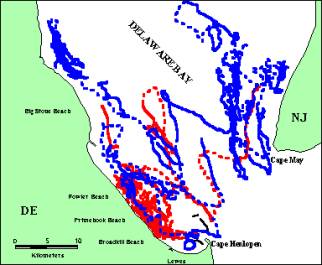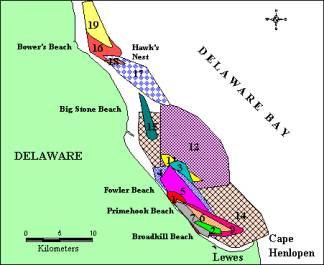Short-term movement patterns of juvenile sandbar sharks (Carcharhinus plumbeus) on their nursery grounds in Delaware Bay
Brad Wetherbee – Department of Biological Sciences, University of Rhode Island
Erin Rechisky and Conrad Recksiek – Department of Animal & Veterinary Sciences, University of Rhode Island
Nancy Kohler, Cami McCanless and Wes Pratt NOAA/NMFS/NEFSC
Movement patterns of juvenile sandbar sharks (Carcharhinus plumbeus) on their nursery grounds were investigated by using acoustic telemetry to actively track shark. Twenty five sharks were fitted with transmitters and their movements continuously monitored for periods of between 6 and 72 h. Tracked sharks spent the majority of their time moving parallel to the coastline, predominately within 3 km of shore and at depths between 2 and 5 m. Although there was a core area of activity near the Delaware coast near the entrance of the bay, several sharks ranged farther from shore and two sharks crossed from one side of the bay to the other. Movements of sharks were heavily influenced by tidal currents, but there were no apparent trends associated with depth or time of day. Sharks tended to swim against the tidal current, presumably to limit the distance they are transported by the strong currents and to increase the amount of time spent in optimal nursery habitat. The results of this study indicate that juvenile sandbar sharks typically move within a restricted area in shallow water, fairly close to shore withinDelaware Bay . However, these sharks are capable of making long distance movements within the bay in short time periods.
For pdf versions of publications resulting from our study click on the manuscript below.
![]() Rechisky, E.L. and B.M. Wetherbee. 2003. Short-term movements of juvenile and neonate sandbar sharks, Carcharhinus plumbeus on their nursery grounds in Delaware Bay . Env. Biol. Fish.68:113-128.
Rechisky, E.L. and B.M. Wetherbee. 2003. Short-term movements of juvenile and neonate sandbar sharks, Carcharhinus plumbeus on their nursery grounds in Delaware Bay . Env. Biol. Fish.68:113-128.
![]() Wetherbee, B.M., E. L. Rechisky, H.L. Pratt Jr., and C.T. McCandless. 2001. Use of telemetry for fishery management: sandbar sharks in Delaware Bay . P. 249-262 In: Electronic tagging and tracking in marine fisheries. Reviews: Methods and Technologies in Fish Biology and Fisheries. Vol. 1. J. Sibert and J. Nielson, eds., Kluwer Academic Press, Dordrecht , the Netherlands .
Wetherbee, B.M., E. L. Rechisky, H.L. Pratt Jr., and C.T. McCandless. 2001. Use of telemetry for fishery management: sandbar sharks in Delaware Bay . P. 249-262 In: Electronic tagging and tracking in marine fisheries. Reviews: Methods and Technologies in Fish Biology and Fisheries. Vol. 1. J. Sibert and J. Nielson, eds., Kluwer Academic Press, Dordrecht , the Netherlands .



 Home
Home Browse
Browse Close
Close Events
Events Maps
Maps Email
Email Brightspace
Brightspace eCampus
eCampus


